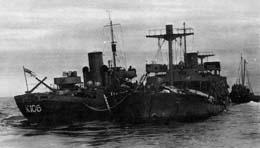On June 20, 1942, the Japanese submarine I-25 torpedoes and shells the SS Fort Camosun off Cape Flattery. The crew abandons ship, but before it sinks it is towed to safety in Neah Bay. The freighter is saved by the crews of rescuing ships and by the fact that its cargo of plywood provides bouyancy. No lives are lost.
In May 1942, the Imperial Japanese Navy dispatched submarine I-25 to patrol the U.S. and Canadian West Coast to look for shipping that might be headed to the Aleutian Islands where the Japanese had invaded the islands of Attu and Kiska. Just after midnight on June 20, I-25, under the command of Commander Meiji Tagami, encountered the SS Fort Camosun approximately 70 miles south southwest of Cape Flattery. The new coal-burning freighter was on her maiden voyage from Victoria to England with zinc, lead, plywood, and other raw materials. The I-25 launched a torpedo, which hit the Fort Camosun. The submarine then surfaced and Commander Tagami ordered the deck gun to open fire, causing further damage.
The Royal Canadian Navy corvette Quesnel raced to the scene, arriving after about six hours. The Quesnel attacked a submerged submarine and with another corvette, the Edmunston, providing cover, rescued the 31-man crew. I-25 left the area and reported the Fort Camosun sunk. But after 24 hours, the freighter was still afloat, although low in the water and unable to steer. The crew of the Edmundston took the freighter under tow and was assisted by the tug Henry Foss from Tacoma, the U.S. Navy tug USS Tatnuck, and the tug Salvage Queen.
The Fort Camosun reached safety in Neah Bay. She was then towed to Esquimalt, B.C., then to Victoria, then to Seattle for repairs. She returned to help in the war effort and survived another torpedoing in the Gulf of Aden.
U.S. destroyers sank the I-25 in 1943.

